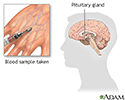Growth hormone stimulation test
Arginine test; Arginine - GHRH test
The growth hormone (GH) stimulation test measures the ability of the body to produce GH.
How the Test is Performed
Blood is drawn several times. Blood samples are taken through an intravenous (IV) line instead of reinserting the needle each time. The test takes between 2 and 5 hours.
The procedure is done the following way:
- An IV is usually placed in a vein, most often the inside of the elbow or the back of the hand. The site is first cleaned with germ-killing medicine (antiseptic).
- The first sample is drawn early in the morning.
- Medicine is given through the vein. This medicine stimulates the pituitary gland to release GH. Several medicines are available. Your health care provider will decide which medicine is best.
- Additional blood samples are drawn over the next few hours.
- After the last sample is taken, the IV line is removed. Pressure is applied to stop any bleeding.
How to Prepare for the Test
DO NOT eat for 10 to 12 hours before the test. Eating food can change the test results.
Some medicines can affect the test results. Ask your provider if you should stop taking any of your medicines before the test.
If your child will have this test, explain how the test will feel. You may want to demonstrate on a doll. The more familiar your child is with what will happen and the purpose of the procedure, the less anxiety they will feel.
How the Test will Feel
When the needle is inserted to draw blood, some people feel moderate pain. Others feel only a prick or stinging sensation. Afterward, there may be some throbbing or a slight bruise. This soon goes away.
Why the Test is Performed
This test is most often done to find out whether a growth hormone deficiency (GH deficiency) is causing slowed growth.
Normal Results
Normal results include:
- Normal peak value, at least 10 ng/mL (10 µg/L)
- Indeterminate, 5 to 10 ng/mL (5 to 10 µg/L)
- Subnormal, 5 ng/mL (5 µg/L)
A normal value rules out hGH deficiency. In some laboratories, the normal level is 7 ng/mL (7 µg/L).
Normal value ranges may vary slightly among different laboratories. Some labs use different measurements or test different samples. Talk to your provider about the meaning of your specific test results.
What Abnormal Results Mean
If this test does not raise GH levels, there is a reduced amount of hGH stored in the anterior pituitary.
In children, this results in GH deficiency. In adults, it may be linked to adult GH deficiency.
Risks
There is little risk involved with having your blood taken. Veins and arteries vary in size from one person to another and from one side of the body to the other. Taking blood from some people may be more difficult than from others.
Other risks associated with having blood drawn are slight, but may include:
- Excessive bleeding
- Multiple punctures to locate veins
- Fainting or feeling lightheaded
- Hematoma (blood accumulating under the skin)
- Infection (a slight risk any time the skin is broken)
Medicines that stimulate the pituitary during the test may cause side effects. The provider can tell you more about this.
References
Dattani MT, Dastamani A. Growth hormone deficiency in children. In: Robertson RP, ed. DeGroot's Endocrinology. 8th ed. Philadelphia, PA: Elsevier; 2023:chap 18.
Guber HA, Oprea M, Russell YX. Evaluation of endocrine function. In: McPherson RA, Pincus MR, eds. Henry's Clinical Diagnosis and Management by Laboratory Methods. 24th ed. Philadelphia, PA: Elsevier; 2022:chap 25.
Patterson BC, Felner EI. Hypopituitarism. In: Kliegman RM, St. Geme JW, Blum NJ, Shah SS, Tasker RC, Wilson KM, eds. Nelson Textbook of Pediatrics. 21st ed. Philadelphia, PA: Elsevier; 2020:chap 573.
Review Date: 7/1/2023
Reviewed By: Charles I. Schwartz, MD, FAAP, Clinical Assistant Professor of Pediatrics, Perelman School of Medicine at the University of Pennsylvania, General Pediatrician at PennCare for Kids, Phoenixville, PA. Also reviewed by David C. Dugdale, MD, Medical Director, Brenda Conaway, Editorial Director, and the A.D.A.M. Editorial team.





